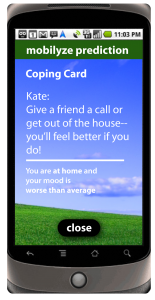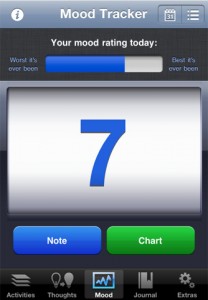Treating Depression with Your Mobile Phone
 To improve the treatment of depression in the United States, the brightest minds in medicine and technology have participated in ongoing collaborations. What is the outcome thus far, you ask? To put it simply, lets just say…there’s an app for that! Actually, there are several!
To improve the treatment of depression in the United States, the brightest minds in medicine and technology have participated in ongoing collaborations. What is the outcome thus far, you ask? To put it simply, lets just say…there’s an app for that! Actually, there are several!
Mobile applications are poised to address a few of the glaring weaknesses in the current psychotherapy model. It is well known that the treatment of depression, anxiety, and other mood disorder symptoms in the United States has poor results, and the problem stems from three root causes:
1. Sheer numbers. In an average year, 9.5% of the U.S. adult population will suffer from mood disorder symptoms, which amounts to roughly 30 million people. Of those, 6.5% will suffer from symptoms of depression, a rate far exceeding the treatment capacity of our nation’s primary care physicians and psychotherapists. In fact, only around 50% of patients suffering from depression symptoms get treatment today. (See: National Institute of Mental Health Statistics)
2. Primary Care is inefficient. While the majority of population can’t access a professional psychotherapist, many can consult their Primary Care physicians. However, these primary care doctors often don’t have time to check up with their patients to optimize dosage when treating depression or anxiety. This lack of attention combined with patients’ non-adherences to their medication regimen causes poor treatment outcomes.
3. The Traditional Psychotherapy model has flaws. In the current system, patients are prescribed treatment after several meetings, and then discuss the treatment outcome in follow up meetings. This system fails to intervene during ‘critical moments’ – the times when those facing symptoms of depression need help the most, and when intervention is most likely to encourage adherence to the patient’s treatment regimen.
The applications developed are meant to directly address these issues. Some are already released, and some are still in beta testing. All of them have shown promising results. The following are some of the most promising applications already on the market or coming soon:
 1. Viary – This application prompts users to engage in 100 behaviors known to help with the treatment of depression, and tracks patient progress on a weekly basis. Suggested behaviors aim to add structure to everyday life, like getting out of bed when the alarm rings. They also aim to stimulate participation in social and novel activities. In a study of around 40 depressed people over an 8-week span, 73.5% of Viary users were considered free of depression symptoms by the end of 8 weeks! Status: Released, but only used after consultation with health professional.
1. Viary – This application prompts users to engage in 100 behaviors known to help with the treatment of depression, and tracks patient progress on a weekly basis. Suggested behaviors aim to add structure to everyday life, like getting out of bed when the alarm rings. They also aim to stimulate participation in social and novel activities. In a study of around 40 depressed people over an 8-week span, 73.5% of Viary users were considered free of depression symptoms by the end of 8 weeks! Status: Released, but only used after consultation with health professional.
2. Mobilyze! – This application enables mobile phones to identify when a patient is in a ‘critical moment’, or is displaying unusually depressed behavior. By using GPS, Bluetooth, Wi-Fi and more, the application monitors mobile communication frequencies and daily movement patterns to create an algorithm predicting a patient’s average behavior. With this information, the application can understand different mood states without the patient needing to self-report. It will then prompt the patient to change their behavior. For example, if the application notices that you have been lying around all day without any social communication, it might prompt you to call a friend. Status: On the way.
3. MedLink Intervention – This application aims to improve patient adherence to medication regimens, and to help physicians optimize the prescription regimen and dosage. It does so by monitoring a patient’s antidepressant medication adherence and their response to treatment and side effects, and then links this information to prescribing physicians to drive better care. Status: On the way.
 4. MoodKit – Developed by a pair of clinical psychologists, MoodKit includes four different sections meant to deal with depression symptoms. The Activities section provides 150 uplifting suggestions for things to do, while Thought Checker reenacts a therapy session in which a person can write down his or her issues, and get feedback on how to deal with the situation. Mood Tracker allows the person to rate their mood on a daily basis, and the MoodKit Journal essentially acts as a personal diary. Status: $5 on iTunes.
4. MoodKit – Developed by a pair of clinical psychologists, MoodKit includes four different sections meant to deal with depression symptoms. The Activities section provides 150 uplifting suggestions for things to do, while Thought Checker reenacts a therapy session in which a person can write down his or her issues, and get feedback on how to deal with the situation. Mood Tracker allows the person to rate their mood on a daily basis, and the MoodKit Journal essentially acts as a personal diary. Status: $5 on iTunes.
5. Mindfulness App – While this application does not directly target depression, it targets mood disorders by encouraging the practice of mindfulness. It provides soundtracks that guide users in developing mindfulness, and allows users to track their progress. In a study of around 40 depressed people over an 8-week period, the Mindfulness Application helped relieve the depression symptoms of 53.1% of participants. Status: $2 on iTunes.
If you have experience with any of these applications, or know of others used for the treatment of depression, please share!
To learn more about depression and treatments, see: FoundHealth.com|Depression.
Learn more about Psychotherapy at FoundHealth.com|Psychotherapy
3 Responses to Treating Depression with Your Mobile Phone
Leave a Reply Cancel reply
Your email address will not be published. Required fields are marked *
*
*
You may use these HTML tags and attributes: <a href="" title=""> <abbr title=""> <acronym title=""> <b> <blockquote cite=""> <cite> <code> <del datetime=""> <em> <i> <q cite=""> <strike> <strong>
Join Our Community
Archives
- January 2023
- December 2022
- September 2022
- August 2022
- June 2022
- May 2022
- April 2022
- March 2022
- February 2022
- January 2022
- December 2021
- November 2021
- October 2021
- September 2021
- August 2021
- July 2021
- June 2021
- May 2021
- March 2021
- September 2020
- August 2020
- July 2020
- June 2020
- May 2020
- April 2020
- March 2020
- February 2020
Subscribe

Sign up to receive FREE toolkit
From Dr. Hyman, #1 NY Times & Amazon Author
We never spam or sell your e-mail







Kinda useless unless you have an iPhone so you should probably SAY iPhone instead of “phone” in your advertising.
Hi Sharon-
I don’t know that these applications are only for iPhone, I don’t necessarily think that is the case, but this may be true. Regardless, thanks for your feedback. Also, just wanted to make clear that this article was not written with any advertising influences – it is meant to be purely educational.
[...] Read the blog. [...]